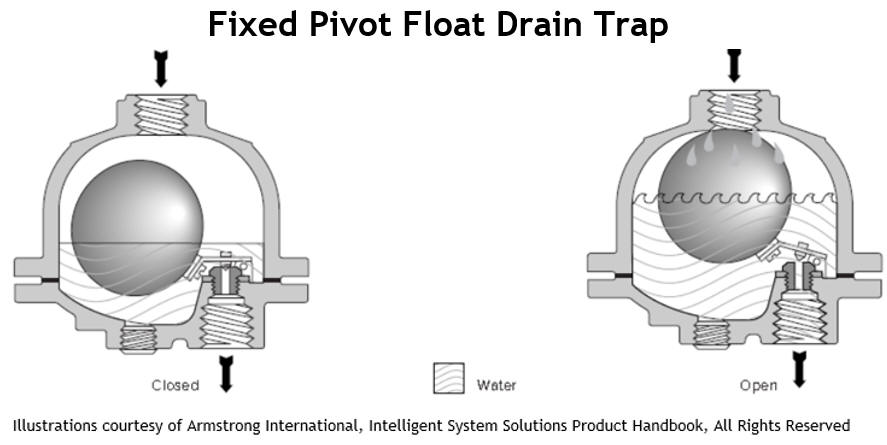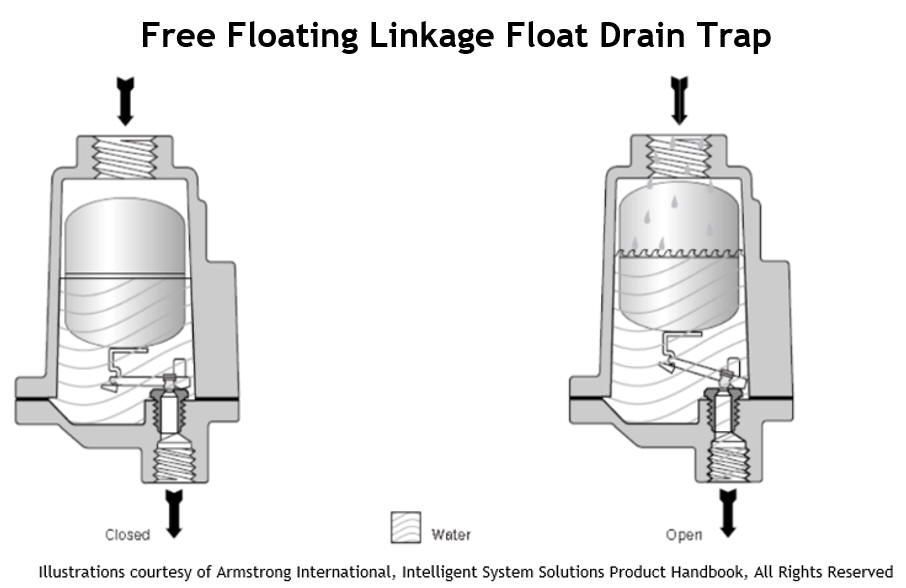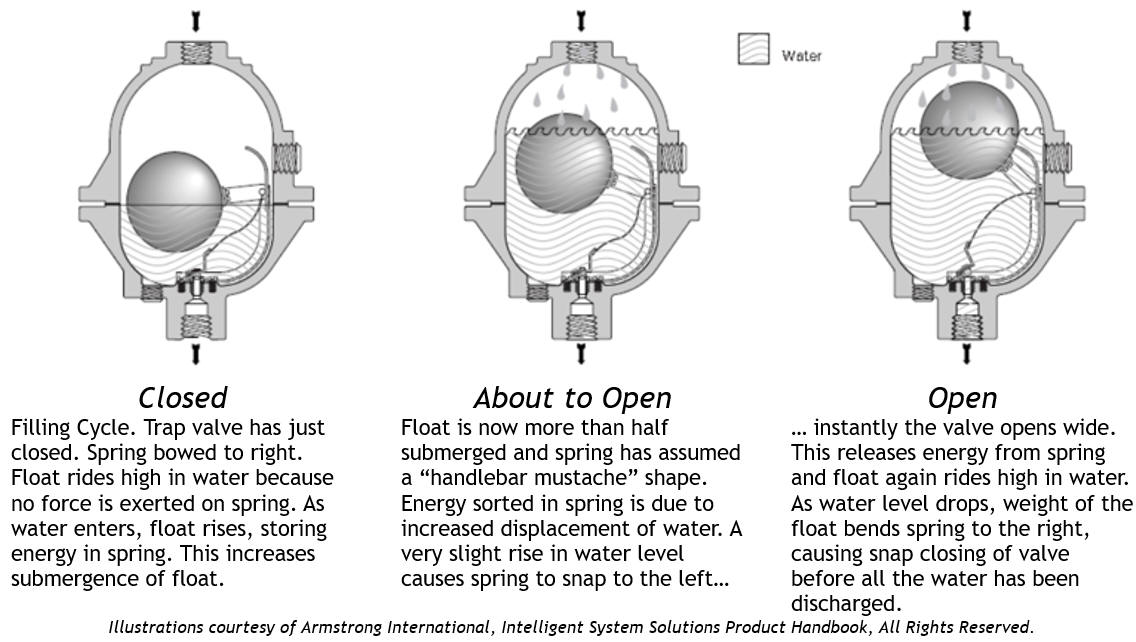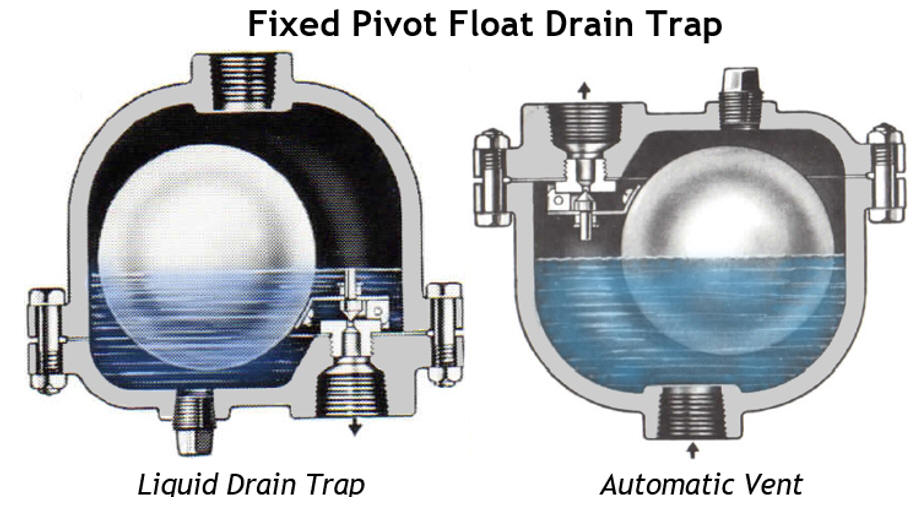Comparison of Float Drain Trap and Inverted Bucket Trap Designs
Call us at 908.362.9981 to speak with a sales engineer
The removal of entrained water within steam
processes is essential to recover energy, protect downstream equipment
and enhance a process. Drain traps play an integral role in removing
condensate from piping systems without loss of steam. Two of the most
common drain traps used in piping systems are float drain traps and
inverted bucket drain traps. These mechanical valves operate on similar
principles however, they are used for different applications. This
article compares and contrasts both designs in detail.
Float
Drain Traps rely on the buoyancy of an internal, weighted float to open
the valve and allow drainage of liquid once the trap body becomes
sufficiently filled with liquid. The standard buoyancy of the float is
calibrated to the specific gravity of water and thus functions well for
water-like liquids; its buoyancy can be modified by adjusting the weight
within the hollow float for use with other liquids.
Some float
drain traps have a top-side inlet and a bottom-side outlet so that when
the trap is installed at a low point in the system where liquid will
accumulate, it gradually fills the trap body while any entrained air or
steam percolates upward and back into the system via the traps inlet
port. In cases where a float drain trap has a side inlet or is not
directly below the liquid source, a vent port on the drain trap is used
to vent air and steam back into the system, preventing vapor lock of the
valve/float assembly.

Fixed pivot style float drain traps connect the
float to a fulcrum/lever/valve assembly such that when there is
sufficient buoyancy of the float, the valve is lifted off its seat and
liquid drains though the seat orifice at a rate based upon the diameter
of the orifice and differential pressure of the system pressure vs.
atmospheric pressure. There are several seat orifice diameters to
accommodate drainage rates sufficient for the system while minimizing
the number of closure cycles and corresponding valve/seat wear.
Free floating linkage and snap action float drain traps are variations
which operate on the same principle but offer advantages in some
applications. A free-floating linkage between the lever and valve
improves the seal against the seat and a snap action style lever ensures
the valve is 100% opened when draining liquid to minimize potential for
clogging the seat orifice.


Key characteristics of a float style drain trap
is that there is always a liquid barrier or seal between the process gas
and drainage, thus when installed where freezing is a concern, a heater
must be installed or the trap needs to be insulated. Float drain traps
do not need to be primed with liquid and they should be periodically
drained via their body drain plug to purge the trap body of any material
that settled within the trap housing such as pipe scale or rust.
Advantages of float drain traps are that they eliminate steam loss
during drainage and they are very reliable due to their overall
simplicity. They can also be used for non-steam applications (compressed
air and other industrial gas systems) to drain entrained liquids because
you can adjust the weight of the float for liquids having extremely low
or high densities. The standard float weight will work for liquids
having a specific gravity as low as 0.40. They can also be used to
separate a heavier liquid from a lighter liquid and as air vents.
Inverted Bucket Traps also operate on the
principle of buoyancy although their mechanical design is more complex
than a float drain trap. Inverted bucket drain traps are mostly used in
steam systems although they can be used in compressed air and industrial
gas systems
The two major components of an inverted bucket drain
trap are the trap body and the internal “inverted bucket”. The flow
pathway is through a tube at the bottom side of the trap body protruding
into the inverted bucket.
At the top of the inverted bucket is a
vent orifice and linkage attached to a plunger and seat. When the bucket
loses buoyancy, the valve is pulled away from the seat and the system
pressure pushes condensate through the seat orifice.
Initially
the trap body and bucket are filled with water, this is referred to as
“priming the trap”. Its purpose is to ensure a liquid seal at the valve
seat orifice and a non-buoyant bucket.
As steam and condensate
enter the trap, it is directed into the inverted bucket; the vent port
allows air and other non-condensable gases to vent to an area above the
inverted bucket. Once sufficient steam accumulates within the bucket, it
becomes buoyant and closes the drain valve. As the steam entrapped in
the bucket condenses into condensate within the bucket, the bucket loses
buoyancy, causing the valve to open and entrained liquid and air to
drain from the system. The volume of condensate purged is equivalent to
the volume of steam required to create buoyancy, which is approximately
1/3 the volume of the inverted bucket.

When used in a compressed air or other
industrial (non-condensable) gas system, the gases which accumulate at
the top of the inverted bucket are vented back to the system piping.
Advantages and Considerations:
Float drain traps
offer advantages such as zero steam loss during drainage, simplicity,
and reliability. They can be adjusted for various liquid densities and
used for non-steam applications like compressed air systems. In
contrast, inverted bucket traps are more adept at handling heavier oil
contamination due to gravity-assisted drainage. They are especially
effective in steam systems and can be used for industrial gas systems.
Both designs require periodic maintenance to remove contaminants,
and heavy oil loading can impede their operation. Float drain traps are
available in a wider variety of materials, can handle higher pressures,
and accommodate higher liquid loads compared to inverted bucket drain
traps.
Fixed pivot style float drain traps have an additional
application as a high capacity air vent. When installed inverted, the
valve remains open to vent gasses and automatically closes after the
body is filled with liquid, causing the float to rise and close the
valve orifice. Air vents are used to assist with pump priming and at
high points in piping to reduce the amount of entrained air or gas in
the system.

In conclusion, while float drain traps offer
simplicity and reliability, inverted bucket traps excel in managing oil
contamination and recovering steam. The choice between the two depends
on the specific requirements of the application. Whether it's steam or
compressed air systems, selecting the right drain trap is essential for
efficient condensate removal and system performance.
Let us put
our 33 years of experience to work for you, think of Factory Direct
Pipeline Products the next time you have a
requirement for a liquid drainer!



